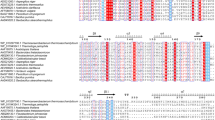Abstract
The complete enzymatic degradation of lignocellulosic biomass requires the cooperative action of cellulosic, hemicellulosic, and lignolytic enzymes such as cellulase, xylanase, laccase, galactosidase, and arabinofuranosidase. Arabinofuranosidases (E.C 3.2.1.55), which belong to the glycoside hydrolase family of enzymes, hydrolyze the 1,3- and 1,5-α-arabinosyl bonds in L-arabinose- containing molecules. L-arabinoses are present in hemicellulosic part of lignocellulosic biomass. Arabinofuranosidases also play an important role in the complete hydrolysis of arabinoxylans. Analysis of the genome project and CAZY database revealed two putative arabinofuranosidase genes in the A. acidocaldarius genome. The aim of the study was cloning, heterologous expression, purification and biochemical characterization of the arabinofuranosidase enzyme encoded in A. acidocaldarius genome. For this purpose, the AbfA gene of the arabinofuranosidase protein was cloned into the pQE-40 vector, heterologously expressed in E. coli BL21 GOLD (DE3) and successfully purified using His-Tag. Biochemical characterization of the purified enzyme revealed that A. acidocaldarius arabinofuranosidase exhibited activity over a wide pH and temperature range with optimum activity at 45 ºC and pH 6.5 in phosphate buffer towards 4-nitrophenyl-α-L-arabinofuranoside as the substrate. In addition, the enzyme is highly stable over wide range of temperature and maintaining 60% of its activity after 90 min of incubation at 80 ºC. Through the bioinformatics studies, the homology model of A. acidocaldarius arabinofuranosidase was generated and the substrate binding site and residues located in this site were identified. Further molecular docking analysis revealed that the substrate located in the catalytically active pose and, residues N174, E175, and E294 have direct interaction with 4-nitrophenyl-α-L-arabinofuranoside. Moreover, based on phylogenetic analysis, A. acidocaldarius arabinofuranosidase exists in the sub-group of intracellular arabinofuranosidases, and G. stearothermophilus and B.subtilis arabinofuranosidases are close relatives of A. acidocaldarius arabinofuranosidase. This is the first study to report the gene cloning, recombinant expression and biochemical and bioinformatic characterization of an auxiliary GH51 arabinofuranosidase from an acidothermophilic bacterium A. acidocaldarius.











Similar content being viewed by others
References
Kirk O, Borchert V, Crone Fuglsang T, C (2002) Industrial enzyme applications. Curr Opin Biotechnol 13:345–351
Pazarlıoğlu N, Telefoncu A (2010) Biotechnology: Basic Principles and Applications. Birlesik Printing, Izmir
Eren K, Çömlekçioğlu Ö, Dostbil U, N (2006) Some microbial enzymes and their usage in industry. K S U Journal of Science and Engineering 9(1):12–19
Deveci R (2006) “Investigation and comparison of glucose isomerase enzyme working compressed bed reactors and fluid bed reactors and fuructose production profiles throughout the reactors”, Çukurova University, Institute of Science, Chemistry Department (Master Thesis)
Demarche P, Junghanns CR, Nair RN, Agathos S (2012) Harnessing the power of enzymes for environmental stewardship. Biotechnol Adv 30:933–953
Xu Q, Adney WS, Ding SY, Micheal HE (2007) “Cellulases for bıomass conversıon, Industrial Enzymes, Springer, Drodrecht, 2007
Suwannarangsee S, Bunterngsook B, Arnthong J, Paemanee A, Thamchaipenet A, Eurwilaichitr L, Laosiripojana N, Champreda V (2012) Optimisation of synergistic biomass-degrading enzyme systems for efficient rice straw hydrolysis using an experimental mixture design. Bioresour Technol 119:252–261
Viikari L, Vehmaanpera J, Koivula A (2012) “Lignocellulosic ethanol: from science to industry”,Biomass and Bioenergy,1–12
Poria V, Sainia JK, Singha S, Nainb L, Kuhad RC (2020) Arabinofuranosidases: characteristics, microbial production, and potential in waste valorization and industrial applications. Bioresour Technol 304:123019
Broeker J, Mechelke M, Baudrexl M et al (2018) The hemicellulose-degrading enzyme system of the thermophilic bacterium Clostridium stercorarium: comparative characterisation and addition of new hemicellulolytic glycoside hydrolases. Biotechnol Biofuels 11:229
Houfani AA, Anders N, Spiess AC, Baldrian P, Benallaoua S (2020) Insights from enzymatic degradation of cellulose and hemicellulose to fermentable sugars– a review. Biomass Bioenergy 134:105481
Miyazaki K (2005) Hyperthermophilic alpha-L: -arabinofuranosidase from Thermotoga maritima MSB8: molecular cloning, gene expression, and characterization of the recombinant protein. Extremophiles 9:399–406
Numan MT, Bhosle NB (2006) Alpha-L-arabinofuranosidases: the potential applications in biotechnology. J Ind Microbiol Biotechnol 33:247–260
Saha BC (2003) Hemicellulose bioconversion. J Ind Microbiol Biotechnol 30:279–291
Van den Burg B (2003) Extremophiles as a source for novel enzymes. Curr Opin Microbiol 6:213–218
Gonçalves TA, Damásio ARL, Segato F, Alvarez TM, Bragatto J, Brenelli LB, Citadini APS, Murakami MT, Ruller R, Leme P, Prade AF, Squina RA, F.M (2012) Functional characterization and synergic action of fungal xylanase and arabinofuranosidase for production of xylooligosaccharides. Bioresour Technol 119:293–299
Wu X, Zhang S, Zhao S, Dai L, Huang S, Liu X, Yu J, Wang L (2022) J Agric Food Chem 70(16):5039–5048
Bouraoui H, Desrousseaux ML, Ioannou E, Alvira P, Manai M, Remond C, Dumon C, Fernandez-Fuentes N, O’Donohue MJ (2016) The GH51 α-L-arabinofuranosidase from Paenibacillus sp. THS1 is multifunctional, hydrolyzing main-chain and side-chain glycosidic bonds in heteroxylans. Biotechnol Biofuels 9:140
Limsakul P, Phitsuwan P, Waeonukul R, Pason P, Tachaapaikoon C, Poomputsa K, Kosugi A, Ratanakhanokchai K (2021) A novel multifunctional arabinofuranosidase/ endoxylanase/β-xylosidase GH43 enzyme from Paenibacillus curdlanolyticus B-6 and its synergistic action to produce arabinose and xylose from cereal arabinoxylan. Appl Environ Microbiol 87:e01730–e01721
Yang W, Bai Y, Yang P, Luo H, Huang H, Meng K, Shi P, Wang Y, Yao B (2015) A novel bifunctional GH51 exo-α-l-arabinofuranosidase/endo-xylanase from Alicyclobacillus sp. A4 with significant biomass-degrading capacity. Biotechnol Biofuels 30:8:197
Bastien G, Arnal G, Bozonnet S, Laguerre S, Ferreira F, Fauré R, Henrissat B, Lefèvre F, Robe P, Bouchez O, Noirot C, Dumon C, O’Donohue M (2013) Mining for hemicellulases in the fungus-growing termite Pseudacanthotermes militaris using functional metagenomics. Biotechnol Biofuels. 14;6(1):78
Long L, Sun L, Lin Q, Ding S, St John FJ (2020) Characterization and functional analysis of two novel thermotolerant α-L-arabinofuranosidases belonging to glycoside hydrolase family 51 from Thielavia terrestris and family 62 from Eupenicillium parvum. Appl Microbiol Biotechnol 104:8719–8733
Bradford MM (1976) A rapid and sensitive method for the quantitation of microgram quantities of protein utilizing the principle of protein-dye binding. Anal Biochem 72(1–2):248–254
Canakci S, Kacagan M, İnan K, Belduz AO, Saha BC (2008) Cloning, purification, and characterization of a thermostable alpha-L-arabinofuranosidase from Anoxybacillus kestanbolensis AC26Sari. Appl Microbiol Biotechnol 81:61–68
Kyoung-Ju K, Kyung-Nam K, Yong-Jin C (2004) Characterization of the arfA gene from Bacillus stearothermophilus No. 236 and its protein product, α-L-Arabinofuranosidase. J Microbiol Biotechnol 143:474–482
Debeche T, Cummings N, Connerton I, Debeire P, O’Donohue MJ (2000) Genetic and biochemical characterization of a highly thermostable alpha-L-arabinofuranosidase from Thermobacillus xylanilyticus. Appl Environ Microbiol 66(4):1734–1736
Gilead S, Shoham Y (1995) Purification and characterization of alpha-L-arabinofuranosidase from Bacillus stearothermophilus T-6. Appl Environ Microbiol 61(1):170–174
Shi H, Zhang Y, Xu B, Tu M, Wang F (2014) Characterization of a novel GH2 family α-L-arabinofuranosidase from hyperthermophilic bacterium Thermotoga thermarum. Biotechnol Lett 36(6):1321–1328
Schwarz WH, Bronnenmeier K, Krause B, Lottspeich F, Staudenbauer WL (1995) Debranching of arabinoxylan: properties of the thermoactive recombinant alpha-L-arabinofuranosidase from Clostridium stercorarium (ArfB). Appl Microbiol Biotechnol 43(5):856–860
Inácio JM, Correia IL, de Sá-Nogueira I (2008) “Two distinct arabinofuranosidases contribute to arabino-oligosaccharide degradation in Bacillus subtilis.”,Microbiology (Reading).;154(Pt9):2719–2729
Pei J, Shao W (2008) Purification and characterization of an extracellular alpha-L-arabinosidase from a novel isolate Bacillus pumilus ARA and its over-expression in Escherichia coli. Appl Microbiol Biotechnol 78(1):115–121
Bourgois TM, Van Craeyveld V, Van Campenhout S, Courtin CM, Delcour JA, Robben J, Volckaert G (2007) Recombinant expression and characterization of XynD from Bacillus subtilis subsp. subtilis ATCC 6051: a GH 43 arabinoxylan arabinofuranohydrolase. Appl Microbiol Biotechnol 75(6):1309–1317
de Wet BJ, Matthew MK, Storbeck KH, van Zyl WH, Prior BA (2008) Characterization of a family 54 alpha-L-arabinofuranosidase from Aureobasidium pullulans. Appl Microbiol Biotechnol 77(5):975–983
Phuengmaung P, Kunishige Y, Sukhumsirichart W, Sakamoto T (2018) Identification and characterization of GH62 bacterial α-l-arabinofuranosidase from thermotolerant Streptomyces sp. SWU10 that preferentially degrades branched l-arabinofuranoses in wheat arabinoxylan. Enzyme Microb Technol 112:22–28
Alias N, Mahadi N, Murad A, Bakar F, Rabu A, Illias R (2011) Expression optimisation of recombinant alpha-L-arabinofuranosidase from Aspergillus niger ATCC 120120 in Pichia pastoris and its biochemical characterization. Afr J Biotechnol 10:6700–6710
Lee JH, Hyun YJ, Kim DH (2011) Cloning and characterization of alpha-L-arabinofuranosidase and bifunctional alpha-L-arabinopyranosidase/beta-D-galactopyranosidase from Bifidobacterium longum H-1. J Appl Microbiol 111:1097–1107
Guerfali M, Gargouri A, Belghith H (2011) Catalytic properties of Talaromyces thermophilus alpha-L-arabinofuranosidase and its synergistic action with immobilized endo-beta-1,4-xylanase. J Mol Catal B 68:192–199
Whitaker JR (1984) Pectic substances, pectic enzymes and haze formation in fruit juices. Enzyme Microb Technol 6:341–349
Ahmed S, Luis AS, Bras JL, Ghosh A, Gautam S, Gupta MN, Fontes CM, Goyal A (2013) “A novel alpha-L-arabinofuranosidase of family 43 glycoside hydrolase (Ct43Araf) from Clostridium thermocellum”,PLoS ONE, 8, e73575
Phuengmaung P, Kunishige Y, Sukhumsirichart W, Sakamoto T (2018) Identification and characterization of GH62 bacterial alpha-L-arabinofuranosidase from thermotolerant Streptomyces sp. SWU10 that preferentially degrades branched L-arabinofuranoses in wheat arabinoxylan. Enzyme Microb Technol 112:22–28
Fujita K, Sakamoto A, Kaneko S, Kotake T, Tsumuraya Y, Kitahara K (2019) Degradative enzymes for type II arabinogalactan side chains in Bifidobacterium longum subsp. Longum. Appl Microbiol Biotechnol 103:1299–1310
Kozakov D, Grove LE, Hall DR, Bohnuud T, Mottarella SE, Luo L, Xia B, Beglov D, Vajda S (2015) The FTMap family of web servers for determining and characterizing ligand-binding hot spots of proteins. Nat Protoc 10(5):733–755
Hövel K, Shallom D, Niefind K, Belakhov V, Shoham G, Baasov T, Shoham Y, Schomburg D (2003) Crystal structure and snapshots along the reaction pathway of a family 51 alpha-L-arabinofuranosidase. EMBO J 22(19):4922–4932
Long L, Sun L, Lin Q Characterization and functional analysis of two novel thermotolerant α-L-arabinofuranosidases belonging to glycoside hydrolase family 51 from and family 62 from.,8719–8733
Acknowledgements
This study was supported partially by TÜBİTAK 1001 (Project Number: 212T116) Scientific and Technological Research Projects Supporting Program.
Author information
Authors and Affiliations
Contributions
Alper Akkaya: Conceptualization, Writing, Supervision. Yunus Ensari: Conceptualization, Methodology, Writing. Emine Erdogan Ozseker: Methodology. Ozge Ozsen Batur: Writing. Gozde Buyuran:Methodology. Serap Evran: Conceptualization, Supervision.
Corresponding author
Ethics declarations
Competing Interests
The authors declare no competing financial interest.
Additional information
Publisher’s Note
Springer Nature remains neutral with regard to jurisdictional claims in published maps and institutional affiliations.
Electronic Supplementary Material
Below is the link to the electronic supplementary material.
Rights and permissions
Springer Nature or its licensor (e.g. a society or other partner) holds exclusive rights to this article under a publishing agreement with the author(s) or other rightsholder(s); author self-archiving of the accepted manuscript version of this article is solely governed by the terms of such publishing agreement and applicable law.
About this article
Cite this article
Akkaya, A., Ensari, Y., Ozseker, E.E. et al. Recombinant Production and Biochemical Characterization of Thermostable Arabinofuranosidase from Acidothermophilic Alicyclobacillus Acidocaldarius. Protein J 42, 437–450 (2023). https://doi.org/10.1007/s10930-023-10117-5
Accepted:
Published:
Issue Date:
DOI: https://doi.org/10.1007/s10930-023-10117-5




